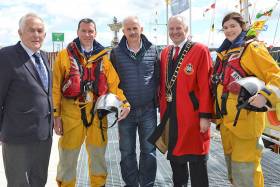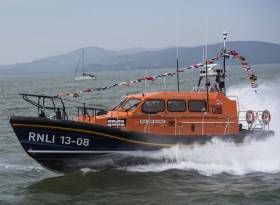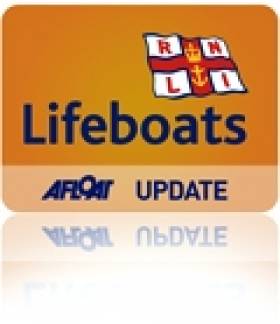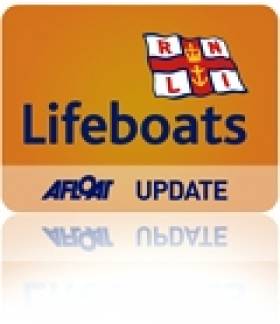Displaying items by tag: Shannon Class
Clogherhead RNLI Launches €150K Lifeboat Appeal
#RNLI - Clogherhead RNLI in Co Louth officially launched the station’s €150,000 Shannon lifeboat appeal on the final day of the Drogheda maritime festival yesterday (Sunday 11 June).
The total cost of Clogherhead’s new Shannon class all-weather lifeboat will be in the region of €2.5 million, the majority of which will be provided through an Irish legacy.
However, the lifeboat station must raise €150,000 towards the cost of the project through a community appeal before the lifeboat is due to go on service in 2019.
The current Clogherhead lifeboat, Doris Bleasdale, is a Mersey class that can reach a top speed of 15 knots.
In the last five years, the lifeboat crew in Clogherhead have launched their lifeboat 58 times and brought 60 people to safety.
With a Shannon class lifeboat, designed by Derry man Peter Eyre, those launches will be even faster with its top speed of 25 knots, and improved range and manoeuvrability thanks to its waterjet propulsion, which also allows the vessel to operate in shallow waters and be intentionally beached.
The official launch took place in the presence of the Mayor of Drogheda Oliver Tully and the Drogheda Harbour Master Captain Martin Donnelly on the new pier for visiting yachts at Drogheda Port, which was itself launched at the weekend during the Irish Maritime Festival.
Speaking at the launch, Drogheda Mayor Oliver Tully paid tribute to the Clogherhead lifeboat crew.
“When we hear of the RNLI going to sea we think of Clogherhead and we think of the all the lives you have saved and your predecessors before you. I would like to thank you for the tremendous work that you do. It is the Clogherhead lifeboat but is supported by everyone in the surrounding area.”
The Mayor also hailed lifeboat mechanic Padraig Rath for keeping the current lifeboat in pristine condition for 24 years.
Coxswain Tomas Whelehan added: “We are delighted that this day is finally here and we can announce the news of a Shannon class lifeboat for the east coast. We have been overwhelmed with the goodwill of people and offers of support. This new lifeboat will represent everyone in our communities as well as those who visit our shores for work or pleasure.
“Our lifeboat crew launch in all conditions at any time of night or day to bring loved ones home. The least we can do is give them the very best in lifeboat technology. Not all callouts are rescues and sometimes there is tragedy but whatever the call, our crews are always ready to answer it and our lifeboat always ready to be launched.”
For further details of how to get involved with the Clogherhead RNLI Shannon project, contact the station at 041 982 2600 and follow the Facebook page for updates.
#RNLI - Arklow man and former lifeboat operations manager Jimmy Tyrrell will have the honour of naming the first class of RNLI lifeboat to be named after an Irish river this Saturday 25 June in Buncrana, Co Donegal.
Lough Swilly RNLI will hold the special naming ceremony and service of dedication from 11.30am to officially name the first Shannon-class lifeboat in Ireland, Derek Bullivant.
The Donegal lifeboat station was the first in Ireland to receive the new €2.4 million lifeboat, which is the most modern and technically advanced lifeboat in the RNLI fleet.
Shortly after its arrival on station, the lifeboat brought three local fishermen to safety after they had been reported missing when their vessel had lost power and drifted out to sea.
The lifeboat was funded by legacies from Derek Bullivant and Valerie Walker. Bullivant was born in Birmingham in 1922 and was a trained chemist before working as an industrial analyst for a company in the metal industry. He went on to start his own company which became one of the biggest aluminium recycling companies in the UK. He always wanted his success to benefit lifesaving and humanitarian charities which led him to provide a generous legacy which helped to fund the Lough Swilly lifeboat.
The second legacy was bequeathed from Valerie Walker from Portsmouth. Walker was a supporter of the RNLI and her legacy has been used to part fund the lifeboat. Her generosity will be remembered and acknowledged by a plaque which will be placed in the boathouse at Lough Swilly lifeboat station.
The Shannon is first class of lifeboat to be propelled by water jets instead of traditional propellers, making it the most agile and manoeuvrable all-weather lifeboat in the fleet.
Waterjets allow the vessel to operate in shallow waters and be intentionally beached. The lifeboat has a top speed of 25 knots and a range of 250 nautical miles, which makes it ideal for offshore searches and rescues in calm and rough seas.
The new lifeboat was developed to operate in the worst of sea conditions and is self-righting, automatically turning the right side up in the event of a capsize. Its unique hull is designed to minimise slamming of the boat in heavy seas and the shock-absorbing seats further protect the crew from impact when powering through the waves.
Commenting on the forthcoming occasion, Lough Swilly RNLI lifeboat operations manager John McCarter said: "Many people will know that we welcomed the lifeboat to Buncrana a little over a year ago but in grand RNLI tradition we officially name and dedicate the lifeboat after that and in doing so remember our generous benefactors who through their legacies have provided this incredible gift to our community.
"We are delighted that Jimmy Tyrrell will be officially naming our lifeboat. Our colleagues in the lifeboat community will know that Jimmy lobbied the RNLI for years to have a class of lifeboat named in recognition of the role Ireland and Irish lifeboat volunteers have played in the work of the charity for 192 years. All other lifeboat classes are named after UK rivers so the Shannon is truly an Irish lifeboat."
The Shannon lifeboat also has another strong Irish connection. Peter Eyre, an RNLI engineer from Derry who works at the charity’s headquarters in Poole, was instrumental in the development of the new lifeboat, designing the hull form at the age of 24.
The first all-weather lifeboat put on service in Lough Swilly was The Good Shepard in 2000.
Arklow Man Greets New Shannon Class Lifeboat
#RNLI - Two maritime legends finally met last bank holiday weekend at the Gathering of the Fleet Maritime Festival when Arklow RNLI lifeboat operations manager Jimmy Tyrell climbed aboard the new Shannon class lifeboat.
Jimmy, and his father before him, lobbied the life-saving charity for many years to call one of their lifeboat classes after an Irish river - and was finally rewarded when the Shannon class lifeboat was put into production last year.
Its arrival at this year’s Gathering of the Fleet in the Wicklow port town was one of the highlights of the event.
The lifeboat is on a tour of RNLI stations to introduce volunteer lifeboat crews to the new vessel, and Jimmy Tyrell was given a warm welcome onboard and had a full tour of the lifeboat from its RNLI crew.
The Shannon class lifeboat is the first all-weather lifeboat to be powered by twin water jets instead of propellers, making it more manoeuvrable and safer to operate in shallow water. It has a top speed of 25 knots and is due to replace the Mersey class lifeboat.
Just prior to the departure of the new Shannon class lifeboat, named Jock & Annie Slater, Arklow RNLI’s crew made a presentation to Jimmy Tyrell and the boat's coxswain to mark the visit and its importance to everyone at Arklow RNLI.
East Coast FM also broadcast their popular morning radio show with Declan Meehan live from the Arklow RNLI lifeboat station, with special guests Diarmuid Gavin and Shane Byrne joined by Arklow RNLI volunteers to get involved in the fun.
The lifeboat crew gave their guests a warm welcome, but had taken the precaution of having a fully kitted-out crew on scene in case they received a call-out during the show.
The Gathering of the Fleet, held in aid of the RNLI, played host to vessels of all shapes and sizes over the August bank holiday weekend.
Commenting on the festival, Arklow RNLI lifeboat press officer Mark Corcoran said: “This weekend was the fruition of months of hard work by the committee. Living on the east coast, the sea is such a big part of everyone’s lives and we wanted to celebrate our proud maritime history and traditions with this Gathering of the Fleet Maritime Festival.
"Thanks to all the boat owners near and far and to the many people who have given their time and energy to make this year’s event something special.”
Douglas RNLI Brings Shannon Class To Irish Sea
#RNLI - The Irish Sea will soon have one of the most advanced lifeboats in service as Douglas RNLI in the Isle of Man has been earmarked to receive one of the new Shannon class.
The new design is 50% faster than the lifeboat it will replace, ensuring that those in need are reached even faster.
The RNLI plans to replace the Tyne class lifeboat at Douglas in 2016, which is reaching the end of its planned 25-year life span. The new lifeboat will cost £2 million (€2.32 million) and the RNLI is currently working to identify whether the funding for the new lifeboat can be raised from legacy gifts or whether fundraising activity is needed. The RNLI will announce this once the funding strategy has been identified.
The Shannon is the first modern RNLI all-weather lifeboat to operate with water jets, not propellers. Capable of 25 knots, the Shannon is 50% faster than the classes it has been designed to replace, which have a lower maximum speed of 17 knots.
The Shannon class will also improve safety for the charity’s volunteer crews, thanks to its shock absorbing seats and on-board computer system, which allows the crews to operate and monitor the lifeboat from the safety of their seats.
Michael Vlasto, RNLI operations director said of the new vessel: "I have had the privilege of being involved with the RNLI for over 38 years. In that time I have witnessed great advances in the charity’s lifeboats and seen many new vessels arrive on station. However, I have never seen our volunteer crews quite as excited as they are about the Shannon.
"This all-weather lifeboat is half as fast again as the lifeboats it has been designed to replace and using water jet propulsion, the manoeuvrability is exceptional. Most importantly though, the Shannon has been carefully developed with the safety of the volunteer crews at the very heart of the design, allowing them to shave life-saving moments off the time it takes to reach those in trouble at sea."
Some of the RNLI Douglas volunteer crew were given the opportunity to experience the Shannon first-hand with a trip around Douglas Bay last weekend as the prototype lifeboat visited the island as part of sea trials that began in January, as previously reported on Afloat.ie.
Afterwards, Douglas coxswain Neal Corran was asked for his immediate thoughts on the new lifeboat. "I was impressed with the boat’s speed and manoeuvrability and look forward to Douglas receiving theirs when it becomes available," he said.
The Shannon has been developed by the RNLI’s in-house team of naval architects, marine engineers and operators - including Irish naval architect Peter Eyre – to replace the majority of Mersey and some remaining Tyne class lifeboats as they reach the end of their operational life (subject to the RNLI’s five-year rolling review of lifesaving assets).
Once the Shannon is rolled out across the UK and Ireland, this class of lifeboat will make up a third of the RNLI all-weather lifeboat fleet, at which point the RNLI will have reached its aim of a 25 knot all-weather lifeboat fleet.
The majority of the 50-plus Shannon class lifeboats to be stationed throughout the UK and Ireland will be built at the RNLI’s new all-weather Lifeboat Centre in Poole, which is currently under construction. Bringing all-weather lifeboat production in-house will save the charity £3.7m annually – the equivalent of 2.5 Shannon class lifeboats.
Sea Trials Won't Weather New Shannon Class Lifeboat
#Lifeboats - The video above shows off a prototype of the RNLI's new lifeboat class, the Shannon, as it undergoes sea trials to determine how it handles the rough weather all too common to the seas around the UK and Ireland.
As previously reported on Afloat.ie, Irish naval architect Peter Eyre has been instrumental in the new lifeboat design, which is nearly 50% faster than the vessels currently in service.
It's also the second RNLI boat to be designed by an Irishman, after the Atlantic 21 developed in the 1970s by Cork-born Rear Admiral Desmond Hoare at the Atlantic College in Wales.
In other RNLI news, tributes were paid in the Isle of Man this week to the founder of the lifeboat institution in an annual ceremony on the Irish Sea island.
As BBC News reports, Sir William Hillary launched an appeal in 1824 that let to the formation of the RNLI, and he went on to serve as a member of the lifeboat crew at Douglas.

































































